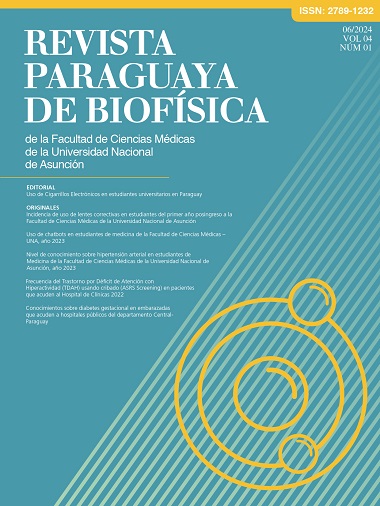Frecuencia del Trastorno por Déficit de Atención con Hiperactividad (TDAH) usando cribado (ASRS Screening) en pacientes que acuden al Hospital de Clínicas 2022
Palabras clave:
Trastorno por Déficit de Atención con Hiperactividad, Adulto, Encuestas y Cuestionarios, Neuroimagen FuncionalResumen
Introducción: El trastorno por déficit de atención con hiperactividad es un problema que se caracteriza por un patrón de conductas que son la inatención y/o hiperactividad-impulsividad, los individuos desarrollan baja autoestima y problemas con el éxito académico. Se destaca la importancia de la biofísica que nos ayuda a descifrar las bases neurobiológicas de la enfermedad. El objetivo es estimar la frecuencia del TDAH en pacientes que acuden al Hospital de Clínicas, San Lorenzo, Paraguay.
Metodología: Estudio observacional, descriptivo de corte transversal con muestreo no probabilístico por conveniencia, en septiembre de 2022, en pacientes consecutivos que acuden al Hospital de Clínicas, San Lorenzo, Paraguay Se utilizó el software de Microsoft Office Excel 2016 para crear una base de datos, a partir del cual se trasladó al software PSPP donde se procesó la información y se calcularon las medidas. Para responder a nuestra pregunta sobre la frecuencia del TDAH en pacientes que acuden al Hospital de Clínicas, el instrumento utilizado fue Attention Deficit Hyperactivity Disorder Self-Report Scale (ASRS v.1.1) en su versión abreviada de seis ítems.
Resultados: Se incluyeron un total de 339 pacientes, donde el 78,5% de los encuestados corresponde al sexo femenino. Se excluyeron todos los formularios incompletos. En cuanto al lugar de la residencia, el 46,6% vive en el departamento central. El valor de la media de edad fue 38,11±13,914 años. El puntaje promedio en el tamizaje ASRS fue de 2,43 puntos. Un 27,1% de los pacientes presentó un resultado presuntivo de TDAH.
Conclusión: El TDAH es un trastorno frecuente en los pacientes adultos y resulta poco reconocido en el país. Es más frecuente en el sexo femenino que en el sexo masculino. El sexo masculino presenta una mayor puntación en el cuestionario ASRS. Así también, los pacientes con TDAH provienen en mayor medida del departamento central.
Referencias
(1) Asociación Americana de Psiquiatría, Guía de consulta de los criterios diagnósticos del DSM 5. Arlington, VA, Asociación Americana de Psiquiatría, 2013.
(2) Albrecht B, Uebel-Von Sandersleben H, Gevensleben H, Rothenberger A. Pathophysiology of ADHD and associated problems—starting points for NF interventions? Front Hum Neurosci [Internet].2015 [citado el 24 de septiembre de 2022];9. Disponible en: https://www.ncbi.nlm.nih.gov/pmc/articles/PMC4478393/
(3) Harpin VA. The effect of ADHD on the life of an individual, their family, and community from preschool to adult life. Arch Dis Child [Internet].2005 [citado el 24 de septiembre de 2022];90(suppl 1):i2–7. Disponible en: https://adc.bmj.com/content/90/suppl_1/i2
(4) Sánchez M, Lavigne R, Romero JF, Elósegui E. Emotion Regulation in Participants Diagnosed With Attention Deficit Hyperactivity Disorder, Before and After an Emotion Regulation Intervention. Front Psychol [Internet]. 2019 [citado el 24 de septiembre de 2022];10. Disponible en: https://www.ncbi.nlm.nih.gov/pmc/articles/PMC6543912/
(5) Beaton DM, Sirois F, Milne E. Experiences of criticism in adults with ADHD: A qualitative study. PLoS One [Internet].2022 [citado el 24 de septiembre de 2022];17(2):Disponible en: https://journals.plos.org/plosone/article?id=10.1371/journal.pone.0263366
(6) Sayal K, Prasad V, Daley D, Ford T, Coghill D. ADHD in children and young people: prevalence, care pathways, and service provision. The lancet Psychiatry [Internet]. el 1 de febrero de 2018 [citado el 25 de septiembre de 2022];5(2):175–86. Disponible en: https://pubmed.ncbi.nlm.nih.gov/29033005/
(7) Song P, Zha M, Yang Q, Zhang Y, Li X, Rudan I. The prevalence of adult attention-deficit hyperactivity disorder: A global systematic review and meta-analysis. J Glob Health [Internet]. 2021 [citado el 25 de septiembre de 2022];11:1–9. Disponible en:https://www.ncbi.nlm.nih.gov/pmc/articles/PMC7916320/
(8) Vos M, Hartman CA. The decreasing prevalence of ADHD across the adult lifespan confirmed. J Glob Health.2022;12:03024.
(9) Polanczyk G V., Willcutt EG, Salum GA, Kieling C, Rohde LA. ADHD prevalence estimates across three decades: an updated systematic review and meta-regression analysis. Int J Epidemiol [Internet]. 2014 [citado el 25 de septiembre de 2022];43(2):434. Disponible en:https://www.ncbi.nlm.nih.gov/pmc/articles/PMC4817588/
(10) Torales J, Kadhum M, Zárate G, Barrios I, González I, Farrell SM, et al. Wellbeing and mental health among medical students in Paraguay. Int Rev Psychiatry [Internet]. el 17 de noviembre de 2019 [citado el 26 de septiembre de 2022];31(7–8):598–602. Disponible en: https://pubmed.ncbi.nlm.nih.gov/31592689/
(11) Kessler, Ronald C., Lenard Adler, Minnie Ames, Olga Demler, Steve Faraone, Eva Hiripi, Mary J. Howes, et al. «The World Health Organization Adult ADHD Self-Report Scale (ASRS): A Short Screening Scale for Use in the General Population». Psychological Medicine 35, n.o 2 (febrero de 2005): 245-56. https://doi.org/10.1017/s0033291704002892.
(12) Pereira-Sanchez, Victor, y Francisco X. Castellanos. «Neuroimaging in Attention-Deficit/Hyperactivity Disorder». Current Opinion in Psychiatry 34, n.o 2 (1 de marzo de 2021): 105-11. https://doi.org/10.1097/YCO.0000000000000669.
(13) Adler LA, Spencer T, Faraone S V., Kessler RC, Howes MJ, Biederman J, et al. Validity of pilot Adult ADHD Self- Report Scale (ASRS) to Rate Adult ADHD symptoms. Ann Clin Psychiatry [Internet]. 2006 [citado el 28 de septiembre de 2022];18(3):145–8. Disponible en: https://pubmed.ncbi.nlm.nih.gov/16923651/
(14) Ramos-Quiroga JA, Daigre C, Valero S, Bosch R, Gómez-Barros N, Nogueira M, Palomar G, Roncero C, Casas M. Validación al español de la escala de cribado del trastorno por déficit de atención/hiperactividad en adultos (ASRS v. 1.1): una nueva estrategia de puntuación. Rev Neurol 2009;48 (09):449-452
(15) National Institute for Health and Care Excellence (NICE). Attention deficit hyperactivity disorder: diagnosis and management. Natl Inst Heal Clin Excell [Internet]. 2019 [citado el 20 de septiembre de 2022];62. Disponible en: https://www.ncbi.nlm.nih.gov/books/NBK493361/
(16) Ramos-Quiroga JA, Casas Brugué M. ¿Prestamos suficiente atención al déficit de atención con hiperactividad en adultos? Aten Primaria [Internet]. febrero de 2009 [citado el 10 de octubre de 2022];41(2):67. Disponible en:https://www.ncbi.nlm.nih.gov/pmc/articles/PMC7022014/
(17) Regier DA, Kuhl EA, Kupfer DJ. The DSM-5: Classification and criteria changes. World Psychiatry [Internet]. junio de 2013 [citado el 10 de octubre de 2022];12(2):92–8. Disponible en: https://pubmed.ncbi.nlm.nih.gov/23737408/
(18) Geffen J, Forster K. Treatment of adult ADHD: a clinical perspective. Ther Adv Psychopharmacol [Internet]. enero de 2018 [citado el 10 de octubre de 2022];8(1):25. Disponible en: https://www.ncbi.nlm.nih.gov/pmc/articles/PMC5761907/
(19) Candar MG. Validez y fiabilidad de las escalas ASRS y WURS-25 para el diagnóstico del trastorno por déficit de atención/hiperactividad en población argentina. Rev Neurol 2021;72 (03):77-84
(20) Cahill BS, Coolidge FL, Segal DL, Klebe KJ, Marle PD, Overmann KA. Prevalence of ADHD and its subtypes in male and female adult prison inmates. Behav Sci Law. 2012 Mar-Apr;30(2):154-66
(21) Willcutt EG. The Prevalence of DSM-IV Attention-Deficit/Hyperactivity Disorder: A Meta-Analytic Review. Neurotherapeutics [Internet]. julio de 2012 [citado el 10 de octubre de 2022];9(3):490. Disponible en: https://www.ncbi.nlm.nih.gov/pmc/articles/PMC3441936/
Descargas
Publicado
Número
Sección
Licencia
Derechos de autor 2024 Cecilia Ariane Ubaldi Cowan, Ana Gabriela Vargas Ayala, Lucas Daniel Vázquez Arrúa, Arturo Gerardo Vázquez Ferreira, Lara Luján Veran San Miguel, Naila Camila Villalba Fernández, Jessica Analía Villalba Fernández, Gabriel Gustavo Zárate Greco, Eric Hernán Benegas Sosa

Esta obra está bajo una licencia internacional Creative Commons Atribución 4.0.





